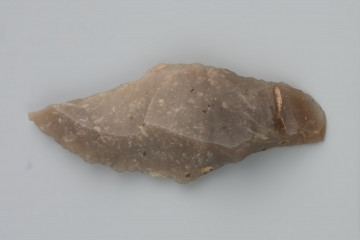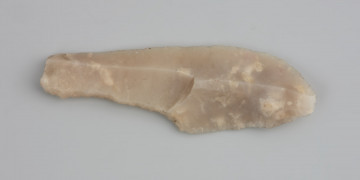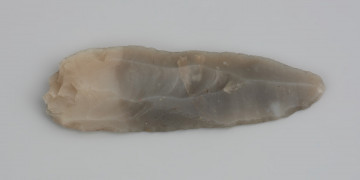
Bromme-type tanged point
11500 p.n.e. — 10800 p.n.e.
National Museum in Szczecin
Part of the collection: Stone Age
The Sviderian tanged point from Stare Czarnowo, the Gryfino district, comes from the archaeological research conducted by R. Richter in the 1930s, from which documentation and a collection of artefacts, mainly Neolithic, survived. The tanged point was made from an elongated fragment of flint, the so-called blade, chipped off from a larger lump. A very high-quality chalky flint was used in its production. It has a handle formed by retouching the edges of the half-shank – breaking off small fragments of flint on both sides, the top and bottom. It is a typical procedure used in the production of tanged points by people representing the archaeological Sviderian culture. The specimen from Stare Czarnowo has a broken top and damages visible on the edges, most probably caused by an impact on a hard surface, e.g., a bone. Traces of this kind are characteristic of arrowheads of projectile weapons. The Sviderian tanged points, tiny specimens such as the one from Stary Czarnowo, were used mainly as arrowheads and are evidence of the use of bows in hunting in the Late Palaeolithic period. Larger specimens were used as javelin and spearheads and probably as cutting tools.
Michał Adamczyk
Author / creator
Dimensions
cały obiekt: height: 3.2 cm, width: 1.5 cm
Object type
tanged point, arrowhead
Technique
carving; peeling, soft masher carving
Material
flint, stone
Origin / acquisition method
acquisition
Creation time / dating
Creation / finding place
Owner
National Museum in Szczecin
Identification number
Location / status

11500 p.n.e. — 10800 p.n.e.
National Museum in Szczecin

11900 p.n.e. — 11000 p.n.e.
National Museum in Szczecin

11900 p.n.e. — 11000 p.n.e.
National Museum in Szczecin
DISCOVER this TOPIC
National Museum in Szczecin
DISCOVER this PATH
Educational path